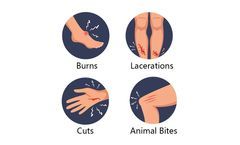Refine by
Tissue Regeneration Articles & Analysis
38 articles found
In surgical tissue recovery, focus is on controlling infection, managing inflammation, and ensuring wound closure. Beneath the surface—anatomically and biologically— the extracellular matrix (ECM) is undergoing remodeling ensure long-term tissue integrity. The ECM is a dynamic, biologically active network that orchestrates the entire process of ...
Glycoprotein 1b on platelet surfaces assists tissue regeneration and injury repair by attaching to von Willebrand factor (vWF) and collagen from damaged blood vessels and when activated P-selectin from platelets becomes externalized it binds to PSGL-1 or CD44 on tumor cells thereby forming a defensive wall against tumor cells. ...
Hydroxyapatite is the same mineral that makes up the majority of our bones and teeth, which is why bioglass can integrate so well with biological tissues. Advantages of Bioglass l Bioactivity: The most significant advantage of bioglass is its ability to bond with living tissue. ...
ByMatexcel
Beyond cancer, understanding cell cycle regulation has implications for tissue regeneration, neurodegeneration, and immune system disorders. ...
Some of the most promising applications include: Regenerative Medicine: Wharton’s jelly MSCs can potentially regenerate damaged tissues and organs due to their ability to differentiate into multiple cell types. ...
Regenerative Medicine: The concept of using mRNA to instruct cells to regenerate tissues is gaining traction. This innovative approach could potentially revolutionize how we treat injuries and degenerative diseases. ...
These traits make them the models par excellence for studying embryonic development, genetic disorders, organogenesis, and tissue regeneration. The realm of zebrafish genome editing services utilizes technologically-advanced tools like CRISPR/Cas9, TALENs, and ZFNs, with CRISPR/Cas9 reigning supreme due to its remarkable efficiency and precision. ...
Nanotechnology: Ovalbumin-based nanoparticles show promise in targeted drug delivery and imaging techniques. 2. Tissue engineering: The protein's biocompatibility makes it a potential candidate for scaffolding materials in tissue regeneration. 3. ...
This precision in directing cell development has the potential to revolutionize the field of regenerative medicine, providing new avenues for tissue repair and regeneration. However, custom mRNA production is not without its challenges, particularly the efficient delivery of artificial mRNA molecules into cells. ...
Collagen is one of the richest proteins in animals, mainly found in the skin, bones, tendons and connective tissue. Due to its key role in cell structure and tissue regeneration, accurate determination of the molecular weight of collagen is of great significance to the biomedical and cosmetics industry.Common Methods for Determining the Molecular ...
Puncture Wounds: Puncture wounds are small holes in soft tissue. They can be caused by objects like wood splinters or needles piercing the skin, usually affecting only the outer layer of tissue. ...
Materials Science: Protein engineering is being used to design novel biomaterials with tailored properties for tissue engineering, drug delivery, and other applications. For example, engineered proteins are being used to create scaffolds for regenerating damaged tissues and to develop nanoparticles for targeted drug delivery. ...
Features of Nano Dressings Dressing is a kind of medical material that can replace damaged skin or tissue, and can promote wound healing and tissue repair, such as gauze, bandage, sponge. ...
These traits make them the models par excellence for studying embryonic development, genetic disorders, organogenesis, and tissue regeneration. The realm of zebrafish genome editing services utilizes technologically-advanced tools like CRISPR/Cas9, TALENs, and ZFNs, with CRISPR/Cas9 reigning supreme due to its remarkable efficiency and precision. ...
They were initially identified in the bone marrow, but have since been found in various other tissues including adipose tissue, peripheral blood, cord blood, fallopian tube, and fetal liver and lung. ...
Epigenetic induction plays an instrumental role in facilitating cell growth, a fundamental process vital for maintaining normal physiological functions such as tissue regeneration, wound healing, and immune responses. The process abrogates the expression of genes that inhibit cell growth and proliferation in unnecessary circumstances and modulates it when ...
Cytokines play pivotal roles in regulating intrinsic and adaptive immunity, hematopoiesis, cell growth, pluripotent cells, and tissue repair. Cytokine Classification Cytokines are categorized into various subtypes, including interleukins (IL), interferons (IFN), tumor necrosis factor (TNF), colony-stimulating factor (CSF), chemokines, and growth factors (GF). ...
They play a role in regulating immune responses, cell growth and differentiation, tissue damage, and repair, among other biological activities. Classification and function Cytokines can be classified into different groups based on their functions, including: interleukin (IL), interferon (IFN), tumor necrosis factor (TNF), colony stimulating factor (CSF), chemokine family, growth ...
The invention of tissue adhesives brought great technological advances in surgery. At present, the tissue adhesives widely used clinically are mainly chemically synthesized cyanoacrylates and fibrin glues. ...














